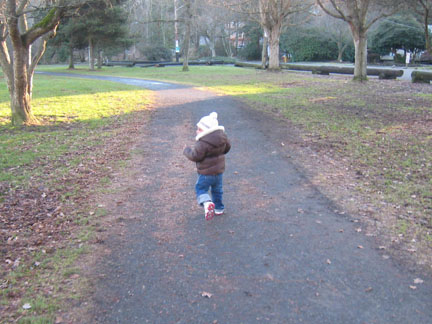
This is how I see her
Several months ago a mother in our parents’ group said she was concerned about putting her daughter in a sleep sack because when her baby pulled herself to stand in her crib she got her feet tangled. Sometimes she fell. The mother wanted to know if anyone else was concerned. When no one answered I said that anything that kept my child in bed, that kept her from climbing over the rail, that, in short, hobbled her was a good thing. So it should come as no surprise that I’m not excited about Josie’s transition to a big-girl bed. I can’t imagine her staying in a bed without bars. In fact, it’s a beautiful miracle that she hasn’t already learned to climb out.
This, my friends, is the rarely-mentioned dark-side of potty training. Freedom to reach the bathroom means freedom to roam the bedroom.
In spite of my reluctance, I have to begin my quest for the right natural, organic mattress. My first stop is the Soaring Heart Natural Bed Company (http://www.soaringheart.com/). I’ve read their ads in my grocery store’s monthly newspaper forever. I walk into the colorless showroom and sit on a mattress made of latex that I’m pretty sure was hand carried from the mountains of China by peasant children with clear skin and good personal hygiene. I tell the salesman I’m looking for a twin size bed for my daughter and ask him to tell me everything.
He says latex is the way to go. It’s guaranteed not to hold an impression for twenty years. I ask if it’s hot, like Memory Foam. He says it’s breathable and shows me a sample of foamy rubber riddled with holes. I ask him about the difference between an inner-spring mattress and latex. He says they don’t have an organic inner spring mattress and (again) that latex is guaranteed not to hold an impression. I ask how I should protect against kid pee. He suggests a machine-washable, liquid-repellant, organic wool topper.
The latex mattress he recommends costs $800. As my mother later says, what is it, made of diamonds? He reminds me Josie will spend one-third of her time on this mattress. Then he points out that it’s a natural material that won’t off-gas and it’s not treated with any kind of chemical flame retardants.
Let’s stop here for a minute and ponder flame retardants, shall we? In the past, these chemicals, in various forms, have been used on our clothes, furniture, carpets, electronics, etc and have been found to cause thyroid hormone disruption, learning and memory impairment, behavioral changes, hearing problems, delayed puberty, decreased sperm count, birth defects and, possibly, cancer (http://www.ewg.org/node/8412). One particularly dangerous category of flame retardants called PBDEs was used on furniture until 2005 (yes, that means anything made prior to 2005 is suspect). These days some mattress manufacturers meet flame resistance regulations by using other (hopefully less toxic) chemicals, while some, like Soaring Heart, insert a fabric fire barrier between the inner layers and outer cover.
Chemical flame retardants aren’t only used on mattresses and furniture. You may find Proban or THPC – which have been linked to genetic abnormalities and damage to the liver, skin and nervous system – on children’s pajamas.
How do you know if pajamas are treated with a chemical retardant?
- You know it’s likely if they contain synthetic fibers.
- You know it’s likely if the tag has washing instructions for “retaining flame resistance.”
How do you know if they aren’t?
- If there’s a sales tag that says the garment is not flame resistant and/or not intended for sleepwear.
- If it says the garment is meant to fit snugly to provide flame resistance.
Of course, if in doubt, contact the manufacturer.
Anyway, back to kid pee… When I recover from my flame-retardant terror I ask how much the pee-resistant wool topper costs – $90. They sell organic sheets and I know they will also be expensive. Then he surprises me by saying the non-organic cotton fluff used for fabric doesn’t test very high for pesticides. He suggests that I buy some good quality conventional cotton sheets and save my money. I ask if sheets are treated with retardants. He says no.
By then, we’ve wandered a full circle of the store and we’re back to the front door. I ask him to write down the prices and descriptions of the options we’ve discussed and as he hands me the paper, he leans in a little. He tells me this guy comes into the store the other day and tells him he’s studying the whales (I’m thinking oh no, for god sake, not the whales). I don’t want to hear what he’s about to say. There’s so much PBDE in the whales that (here it comes) their blubber is no longer flammable. Bam! There it is. We were having such a nice time.
I say goodbye and as I walk to the car I’m thinking about puppies and bunnies and all soft fuzzy things – anything but the whales.
Stay tuned for Mattress Quest part II at Bedrooms and More (www.bedroomsandmore.com). To be continued…

Please let me know what you decide/find. Viv is eyeing Lulu’s bed. I’m thinking that the big one needs a real bed. Just worried that Viv will roam and Lulu will follow her…